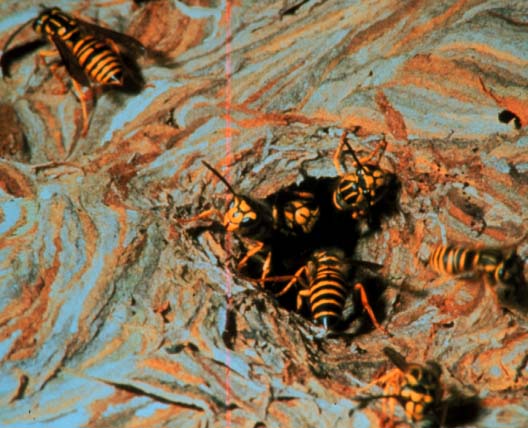
Southern yellowjackets, Vespula squamosa (Drury) (Hymenoptera: Vespidae), at nest entrance. Photo by G. McIlveen, Jr.
Common Name: Southern yellowjacket
Scientific Name: Vespula squamosa (Drury)
Order: Hymenoptera
Description: Workers are about 1/2 inch long, with clear wings. The body is black with yellow characteristic markings on the head, thorax and abdomen. The body is not hairy.
Other common Texas “wasps” include: the eastern yellowjacket, Vespula maculifrons (Buysson) (generally found in eastern Texas), paper wasps (such as Polistes carolina), hornets (such as the baldfaced hornet, Dolichovespula maculata), the cicada killer wasp (Sphecius speciosus), and mud daubers (such as Chalybion californicus).
Life Cycle: The colony is initiated by a single queen that survived the winter. The queen is very large and predominately orange, differing from the worker and male wasps in a colony. After feeding on nectar and arthropods in early spring, the queen’s ovaries develop and she seeks a nesting site. There she constructs a nest of 20 to 45 cells and produces eggs that hatch into larvae. The queen feeds these larvae nectar and arthropod prey and in about 30 days the first worker wasps emerge from the pupal stage. After the number of worker wasps increase, the queen no longer leaves the nest. Colonies can contain up to 4,000 workers. Late in the summer, workers construct larger reproductive cells in which male and female wasps are produced. After they emerge, they leave the nest, mate. Thereafter, queens seek hibernation sites while males swarm in high numbers over hilltops and vegetation.

Southern yellowjackets, Vespula squamosa (Drury) (Hymenoptera: Vespidae), developmental stages; larval stages (instars), pupae, adult.
Photo by Drees.
Habitat, Food Source(s), Damage: Mouthparts are for chewing. Colonies, constructed out of chewed vegetable fiber that forms paper carton, occur in disturbed habitats such as yards and roadsides. Nests are most often underground, but occasionally are found in wall voids and indoors. In Texas, some colonies can survive for several years and continue to grow. Colonies in Texas and other southern states have been reported that are 6 ft across. In exposed and underground sites, nests are spherical and consists of a number of round combs, attached one below another, and surrounded by a many-layered outer cover. Worker wasps leave the nest and seek protein sources such as live insects and animal carcasses, foraging around picnic tables, garbage cans and other locations. They do not make nor store honey.
Pest Status: Venomous, stinging social insect, that is abundant in urban areas; when nests are disturbed, defending worker wasps can inflict multiple stings; foraging worker wasps may be a nuisance at picnics and other outdoor events.
For additional information, contact your local Texas A&M AgriLife Extension Service agent or search for other state Extension offices.
Literature: Akre et al. 1981; McIlveen & Hamman 1991.